Archive for July, 2013
» posted on Monday, July 29th, 2013 by Linda Lou Burton
Saturday’s Scene
 Linda Burton posting from Madison, Wisconsin – Cave Aged Bandaged Cheddar from Bleu Mont Dairy in Blue Mounds, Wisconsin sells for twenty-five dollars a pound. I bought $8.50 worth; yes, I finally found that Wisconsin cheese I’ve been looking for. I discovered it at the Dane County Farmers’ Market last Saturday, on Capitol Square, right in the heart of downtown. I can state with almost a certainty that you’ve never been to a Farmers’ Market like this one; it claims to be the largest producers-only farmers’ market in the United States. And all those open-air tents against the background of the capitol make it without doubt the prettiest farmers’ market in the country. The DCFM has been happening since the 70’s; blue tents and white shelter as many as 300 vendors selling everything from cheeses and meats to vegetables and flowers. It happens every Saturday during the
Linda Burton posting from Madison, Wisconsin – Cave Aged Bandaged Cheddar from Bleu Mont Dairy in Blue Mounds, Wisconsin sells for twenty-five dollars a pound. I bought $8.50 worth; yes, I finally found that Wisconsin cheese I’ve been looking for. I discovered it at the Dane County Farmers’ Market last Saturday, on Capitol Square, right in the heart of downtown. I can state with almost a certainty that you’ve never been to a Farmers’ Market like this one; it claims to be the largest producers-only farmers’ market in the United States. And all those open-air tents against the background of the capitol make it without doubt the prettiest farmers’ market in the country. The DCFM has been happening since the 70’s; blue tents and white shelter as many as 300 vendors selling everything from cheeses and meats to vegetables and flowers. It happens every Saturday during the  summer from 6:30 AM to 2 PM; Wednesdays too, although the weekday market doesn’t draw as many vendors, or crowds. There are just a few strict Do’s and Don’ts – it always happens, regardless of weather, that’s a Do; and all items must be produced locally by the vendor. No resale is allowed, and no pets are allowed at the market. Any vendor you see waited a long time for an invite to sell at the DCFM; the average wait is five years. The best chefs want to buy at the market, and the
summer from 6:30 AM to 2 PM; Wednesdays too, although the weekday market doesn’t draw as many vendors, or crowds. There are just a few strict Do’s and Don’ts – it always happens, regardless of weather, that’s a Do; and all items must be produced locally by the vendor. No resale is allowed, and no pets are allowed at the market. Any vendor you see waited a long time for an invite to sell at the DCFM; the average wait is five years. The best chefs want to buy at the market, and the  best producers want to sell there; DCFM producers regularly receive national and international recognition for the quality of their products. I could see that as I walked around the square; red torpedo onions shining like a work of art; bundles of garlic rowed up like pretty girls at a party; lemon scones plump with blueberries; fresh sweet corn. And award-winning cheese. » read more
best producers want to sell there; DCFM producers regularly receive national and international recognition for the quality of their products. I could see that as I walked around the square; red torpedo onions shining like a work of art; bundles of garlic rowed up like pretty girls at a party; lemon scones plump with blueberries; fresh sweet corn. And award-winning cheese. » read more
» posted on Saturday, July 27th, 2013 by Linda Lou Burton
Just Talking
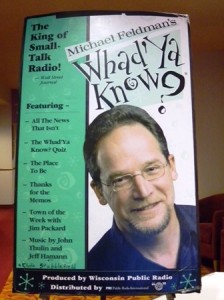 Linda Burton posting from Madison, Wisconsin – “It’s like melted cheese stuck to a gold-plated toaster,” said the voice coming out of the speaker. The voice was that of Mark Leibovich, guest interviewee on today’s talk show, Whad’Ya Know; broadcast Saturday mornings via Wisconsin Public Radio (WPR) and distributed by Public Radio International (PRI). I normally catch it on whatever National Public Radio (NPR) station serves wherever I happen to be, but today I’m in the thick of it, sitting “live” in the studio audience in downtown Madison’s Monona Terrace Center. Full of pre-show sugar-drizzled donuts and logger’s coffee, I watched host Michael Feldman wander around the stage and out into the audience, shirttail loose, aiming for casual; aiming to put us at ease. We were prompted before the “On Air” flashed; “I ask whad’ya know,” he said; “then you answer ‘Not much! You?’” We practiced a few times; “You need the gesture,” he chided,
Linda Burton posting from Madison, Wisconsin – “It’s like melted cheese stuck to a gold-plated toaster,” said the voice coming out of the speaker. The voice was that of Mark Leibovich, guest interviewee on today’s talk show, Whad’Ya Know; broadcast Saturday mornings via Wisconsin Public Radio (WPR) and distributed by Public Radio International (PRI). I normally catch it on whatever National Public Radio (NPR) station serves wherever I happen to be, but today I’m in the thick of it, sitting “live” in the studio audience in downtown Madison’s Monona Terrace Center. Full of pre-show sugar-drizzled donuts and logger’s coffee, I watched host Michael Feldman wander around the stage and out into the audience, shirttail loose, aiming for casual; aiming to put us at ease. We were prompted before the “On Air” flashed; “I ask whad’ya know,” he said; “then you answer ‘Not much! You?’” We practiced a few times; “You need the gesture,” he chided, 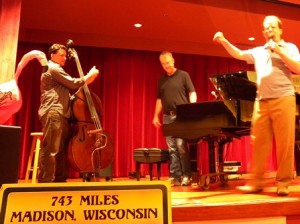 flinging arms back and chest forward. “That makes it more….you know.” He chided announcer Sara Nics on her retro-chic outfit, totally wasted on a radio show – jeans split at the knees, spiked-heel leather boots; a plaid 70’s jacket. “I wouldn’t let my daughter go out like that,” he said. She did a little Charleston before she took her seat; we laughed, warming up to the process. Whad’Ya Know has been on since 1985; Wall Street Journal has dubbed Feldman “King of Small Talk Radio.” His show is meant to be silly; even
flinging arms back and chest forward. “That makes it more….you know.” He chided announcer Sara Nics on her retro-chic outfit, totally wasted on a radio show – jeans split at the knees, spiked-heel leather boots; a plaid 70’s jacket. “I wouldn’t let my daughter go out like that,” he said. She did a little Charleston before she took her seat; we laughed, warming up to the process. Whad’Ya Know has been on since 1985; Wall Street Journal has dubbed Feldman “King of Small Talk Radio.” His show is meant to be silly; even 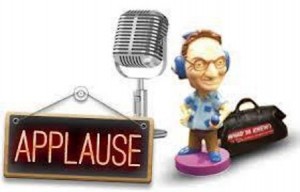 serious subjects get the low-key voice (think Groucho Marx). Today’s interview with Leibovich followed that path, as the author discussed his ire-arousing new book, This Town. Two Parties and a Funeral – plus plenty of valet parking in America’s Gilded Capital. “Washington DC,” Leibovich said, “is the place people go to get famous.” Feldman dug for “whys.” » read more
serious subjects get the low-key voice (think Groucho Marx). Today’s interview with Leibovich followed that path, as the author discussed his ire-arousing new book, This Town. Two Parties and a Funeral – plus plenty of valet parking in America’s Gilded Capital. “Washington DC,” Leibovich said, “is the place people go to get famous.” Feldman dug for “whys.” » read more
» posted on Thursday, July 25th, 2013 by Linda Lou Burton
The Town Square
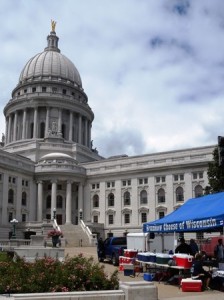 Linda Burton posting from Madison, Wisconsin – My favorite thing about the Wisconsin State Capitol is its “town squareness.” You know, like the courthouse square in most of small-town America; the village green; the gathering place. Make no mistake; the building is massive, and elegant; and still serves all three branches of state government. The governor’s office is on the first floor; visitors are welcome in the adjoining conference room, a Venetian palace look-alike with fancy-dancy paintings on every wall; the ceiling too, look up, for sure. The Senate and the Assembly each have chambers on the second floor, as does the Supreme Court; the fourth wing is the North Hearing Room. Everything has a glamorous look; there are marbles and woods from Germany, and Italy, and France; and, to stay true to its roots, Wisconsin, of course. But it shares its elegance; it’s
Linda Burton posting from Madison, Wisconsin – My favorite thing about the Wisconsin State Capitol is its “town squareness.” You know, like the courthouse square in most of small-town America; the village green; the gathering place. Make no mistake; the building is massive, and elegant; and still serves all three branches of state government. The governor’s office is on the first floor; visitors are welcome in the adjoining conference room, a Venetian palace look-alike with fancy-dancy paintings on every wall; the ceiling too, look up, for sure. The Senate and the Assembly each have chambers on the second floor, as does the Supreme Court; the fourth wing is the North Hearing Room. Everything has a glamorous look; there are marbles and woods from Germany, and Italy, and France; and, to stay true to its roots, Wisconsin, of course. But it shares its elegance; it’s 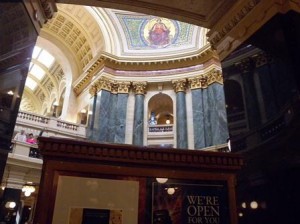 an open-door capitol. Every entrance is available, on every side; walk in and look around, or take a tour, or express your opinion, seven days a week. Visit on a Saturday, when the Farmers Market tents surround the square. People come in to be dazzled; posing for pictures on the balcony as they wave at their photographer down below; arms filled with
an open-door capitol. Every entrance is available, on every side; walk in and look around, or take a tour, or express your opinion, seven days a week. Visit on a Saturday, when the Farmers Market tents surround the square. People come in to be dazzled; posing for pictures on the balcony as they wave at their photographer down below; arms filled with 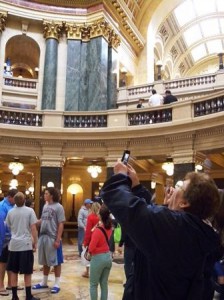 parcels of cheese, or farm-fresh kohlrabi, from the stands outside. The setting is magnificent; where else could you find a background like that? Where else such history, or such art? Where else such a forum for being heard? I had a conversation with the Capitol Police, whose desk fronts the Governor’s Office. And I had a conversation with one of the Solidarity Singers, who has been arrested by the Capitol Police at least five times during the last few weeks. They share a difficult problem; I listened to their conundrum. » read more
parcels of cheese, or farm-fresh kohlrabi, from the stands outside. The setting is magnificent; where else could you find a background like that? Where else such history, or such art? Where else such a forum for being heard? I had a conversation with the Capitol Police, whose desk fronts the Governor’s Office. And I had a conversation with one of the Solidarity Singers, who has been arrested by the Capitol Police at least five times during the last few weeks. They share a difficult problem; I listened to their conundrum. » read more
» posted on Tuesday, July 23rd, 2013 by Linda Lou Burton
Lake, City, Lake
 Linda Burton posting from Madison, Wisconsin – Seen from outer space, it’s clear. “Lake, City, Lake” is the trademark for Madison, Wisconsin and that’s just what you see – Lake Mendota, then the city, centered on an isthmus, then Lake Monona. Madison is actually described as the City of Four Lakes; besides those two are Lakes Waubesa and Kegonsa; they are south of the city but part of the four successive lakes of the Yahara River. There is even a fifth, Lake Wingra; connected to the Yahara by Wingra Creek and within the city limits. So what do you do with all that water? Well, you enjoy it. The sight of it enhances everything else; it’s just plain pretty
Linda Burton posting from Madison, Wisconsin – Seen from outer space, it’s clear. “Lake, City, Lake” is the trademark for Madison, Wisconsin and that’s just what you see – Lake Mendota, then the city, centered on an isthmus, then Lake Monona. Madison is actually described as the City of Four Lakes; besides those two are Lakes Waubesa and Kegonsa; they are south of the city but part of the four successive lakes of the Yahara River. There is even a fifth, Lake Wingra; connected to the Yahara by Wingra Creek and within the city limits. So what do you do with all that water? Well, you enjoy it. The sight of it enhances everything else; it’s just plain pretty 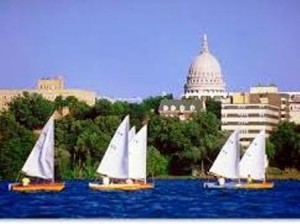 to look at, day or night. And of course you play on it, summer, winter, spring and fall. So just how did Madison, Wisconsin, a pleasant city that’s home to 233,209 (US 2010 Census) pleasant residents, have the good fortune of being estabished in such an ideal location, and being selected as the perfect spot for the capital of the state? It all started with a man by the name of James Duane Doty (1799-1865), an ambitious fellow from New York who had some good luck, and some bad. He headed west at a young age, settling in Detroit in 1818, where he began practicing law. In 1820 he participated in an expedition led by Michigan Territory’s
to look at, day or night. And of course you play on it, summer, winter, spring and fall. So just how did Madison, Wisconsin, a pleasant city that’s home to 233,209 (US 2010 Census) pleasant residents, have the good fortune of being estabished in such an ideal location, and being selected as the perfect spot for the capital of the state? It all started with a man by the name of James Duane Doty (1799-1865), an ambitious fellow from New York who had some good luck, and some bad. He headed west at a young age, settling in Detroit in 1818, where he began practicing law. In 1820 he participated in an expedition led by Michigan Territory’s  governor, Lewis Cass, to the headwaters of the Mississippi River; that brought him some recognition and gave him a taste of the wilderness further west. President James Monroe appointed him to a federal judgeship; that brought him to Green Bay in 1824. Well aware of the travel hazards between the west and east sides of Lake Michigan, Doty petitioned Congress to split Michigan Territory into two parts. » read more
governor, Lewis Cass, to the headwaters of the Mississippi River; that brought him some recognition and gave him a taste of the wilderness further west. President James Monroe appointed him to a federal judgeship; that brought him to Green Bay in 1824. Well aware of the travel hazards between the west and east sides of Lake Michigan, Doty petitioned Congress to split Michigan Territory into two parts. » read more
» posted on Sunday, July 21st, 2013 by Linda Lou Burton
Eating Out Is A Responsibility
 Linda Burton posting from Madison, Wisconsin – “Madison folks are big on Sunday brunch,” I read. Since that’s my idea of a good Sunday too, I searched out the possibilities, settling on the Marigold Kitchen, the #1 Best, according to several reviewers. I liked its location too, right off Capitol Square; I could get my outdoor capitol photos while parked in the same spot. The weather had cooled, at last, to a civilized 73 degrees. The drive was easy, a straight shot towards the capitol down Washington Avenue, onto the isthmus that is Central Madison. This city of lakes, you see, really is; Lake Mendota and Lake Monona are two of the smaller lakes left by those
Linda Burton posting from Madison, Wisconsin – “Madison folks are big on Sunday brunch,” I read. Since that’s my idea of a good Sunday too, I searched out the possibilities, settling on the Marigold Kitchen, the #1 Best, according to several reviewers. I liked its location too, right off Capitol Square; I could get my outdoor capitol photos while parked in the same spot. The weather had cooled, at last, to a civilized 73 degrees. The drive was easy, a straight shot towards the capitol down Washington Avenue, onto the isthmus that is Central Madison. This city of lakes, you see, really is; Lake Mendota and Lake Monona are two of the smaller lakes left by those 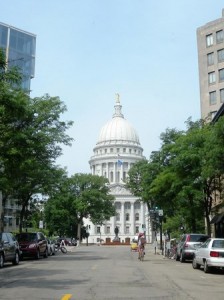 famous glaciers of long ago, separated by a strip that’s just wide enough to build a city on. The capitol sits in the middle with a few blocks in either direction towards the water; possibly the most pleasant spot nature and humankind could have put together for a Sunday morning outing. I parked in a meterless spot right beside the capitol under a shade tree; Marigold Kitchen was just a block down Pinckney Street. Somebody else had read the reviews; the outdoor tables were
famous glaciers of long ago, separated by a strip that’s just wide enough to build a city on. The capitol sits in the middle with a few blocks in either direction towards the water; possibly the most pleasant spot nature and humankind could have put together for a Sunday morning outing. I parked in a meterless spot right beside the capitol under a shade tree; Marigold Kitchen was just a block down Pinckney Street. Somebody else had read the reviews; the outdoor tables were 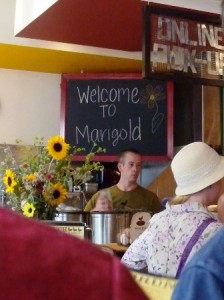 full and the line to get inside hung outside; someone passed out menus to study while we stood. The routine was set up for efficiency; order at the counter, pay and get your number; get seated when the next table came open. I’d never thought of adding fresh sweet corn and yellow squash to my scrambled eggs, but that’s what the Scrambler offered and that’s what I chose, along with Marigold Potatoes and Rosemary French Toast. “A table there, near the door,” was offered with a frantic point; I scooted fast and grabbed my spot. Did I mention the noise? » read more
full and the line to get inside hung outside; someone passed out menus to study while we stood. The routine was set up for efficiency; order at the counter, pay and get your number; get seated when the next table came open. I’d never thought of adding fresh sweet corn and yellow squash to my scrambled eggs, but that’s what the Scrambler offered and that’s what I chose, along with Marigold Potatoes and Rosemary French Toast. “A table there, near the door,” was offered with a frantic point; I scooted fast and grabbed my spot. Did I mention the noise? » read more
» posted on Friday, July 19th, 2013 by Linda Lou Burton
Looking For Cheese
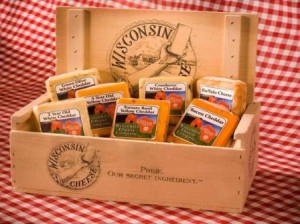 Linda Burton posting from Madison, Wisconsin – It must be true. I’ve always heard that Wisconsin is the place for cheese, and today I looked for signs of that as I drove from Saint Paul to Madison. Signs I saw, all urging me to shop; Cheese Alley, Cheese Chalet, Mousehouse. But I didn’t stop; the heat that’s been sitting on top of the northern states like a steam-pot dome was in its fifth day and I couldn’t leave the cats in the car; even a quick-stop for gas was almost too long to have the cooler off. I parked the car under a tree last night; it was shaded from the
Linda Burton posting from Madison, Wisconsin – It must be true. I’ve always heard that Wisconsin is the place for cheese, and today I looked for signs of that as I drove from Saint Paul to Madison. Signs I saw, all urging me to shop; Cheese Alley, Cheese Chalet, Mousehouse. But I didn’t stop; the heat that’s been sitting on top of the northern states like a steam-pot dome was in its fifth day and I couldn’t leave the cats in the car; even a quick-stop for gas was almost too long to have the cooler off. I parked the car under a tree last night; it was shaded from the 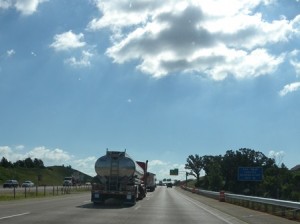 early morning sun as I loaded up this morning but the humidity knew no bounds; by the time I brought the cats out I was soaking wet. “Water!” I said, gulping down half a bottle of Aquafina before hitting the freeway. It wasn’t the best of drives. Since I was headed east, the morning sun was a glare. The windshield was buggy from earlier hits; I hadn’t taken the time to scrub it down before I left. There isn’t much of Minnesota before you get to the St Croix River, a tributary of the Mississippi; and zap, once you’re across you are in Wisconsin.
early morning sun as I loaded up this morning but the humidity knew no bounds; by the time I brought the cats out I was soaking wet. “Water!” I said, gulping down half a bottle of Aquafina before hitting the freeway. It wasn’t the best of drives. Since I was headed east, the morning sun was a glare. The windshield was buggy from earlier hits; I hadn’t taken the time to scrub it down before I left. There isn’t much of Minnesota before you get to the St Croix River, a tributary of the Mississippi; and zap, once you’re across you are in Wisconsin. 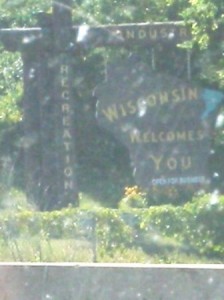 I snapped a photo of my rather inauspicious entry, but it can never achieve more than “token photo” status; you see the bugs on the windshield and the glaring morning sun; the “Wisconsin Welcomes You” sign was half-hidden in the shade. “You’re Wisconsin cats now,” I announced anyhow; as tanker trucks zoomed by, seemingly oblivious to the orange cones, and the swerving lane changes as we passed through endless construction zones. I settled in the right-hand lane, looking for dairy farms, and looking for cheese. » read more
I snapped a photo of my rather inauspicious entry, but it can never achieve more than “token photo” status; you see the bugs on the windshield and the glaring morning sun; the “Wisconsin Welcomes You” sign was half-hidden in the shade. “You’re Wisconsin cats now,” I announced anyhow; as tanker trucks zoomed by, seemingly oblivious to the orange cones, and the swerving lane changes as we passed through endless construction zones. I settled in the right-hand lane, looking for dairy farms, and looking for cheese. » read more
» posted on Wednesday, July 17th, 2013 by Linda Lou Burton
Hmong Americans
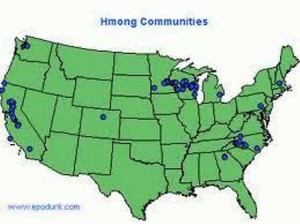 Linda Burton posting from Saint Paul, Minnesota –Saint Paul’s population is 15% Asian, third highest Asian population in the list of capital cities. That’s according to the 2010 US Census, which also denotes specific ethnicity; it tells us that 260,073 people of Hmong descent live in the United States, with the largest Hmong American community right here in Saint Paul. The United States opened its doors to Hmong war refugees with the Refugee Assistance Act of 1975 following the communist takeover of Laos; more than 18,000 Hmong had died in support of US forces during the Vietnam conflict. By 1978 about 30,000 Hmong had immigrated; primarily men directly associated with the war efforts. When the Refugee Act of 1980 was passed, families
Linda Burton posting from Saint Paul, Minnesota –Saint Paul’s population is 15% Asian, third highest Asian population in the list of capital cities. That’s according to the 2010 US Census, which also denotes specific ethnicity; it tells us that 260,073 people of Hmong descent live in the United States, with the largest Hmong American community right here in Saint Paul. The United States opened its doors to Hmong war refugees with the Refugee Assistance Act of 1975 following the communist takeover of Laos; more than 18,000 Hmong had died in support of US forces during the Vietnam conflict. By 1978 about 30,000 Hmong had immigrated; primarily men directly associated with the war efforts. When the Refugee Act of 1980 was passed, families 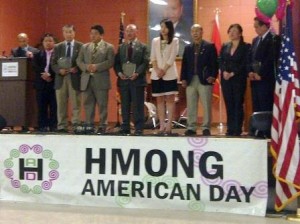 were permitted to come. Political controversy surrounded the remaining Hmong refugees after the 1980 immigration wave – should they be repatriated, allowed to immigrate, or left in the refugee camps in Thailand? Eventually tens of thousands of Thai-based Hmong refugees were granted US immigration rights, leading to highly emotional reunions of long-separated Hmong families. As of the 2010 US Census, the largest Hmong American populations were in California, Minnesota, Wisconsin, North Carolina, and Michigan, with the Saint Paul metro area being home to the largest group. It is a strong and tightly woven community, as immigrants adapt to American culture while still maintaining their homeland
were permitted to come. Political controversy surrounded the remaining Hmong refugees after the 1980 immigration wave – should they be repatriated, allowed to immigrate, or left in the refugee camps in Thailand? Eventually tens of thousands of Thai-based Hmong refugees were granted US immigration rights, leading to highly emotional reunions of long-separated Hmong families. As of the 2010 US Census, the largest Hmong American populations were in California, Minnesota, Wisconsin, North Carolina, and Michigan, with the Saint Paul metro area being home to the largest group. It is a strong and tightly woven community, as immigrants adapt to American culture while still maintaining their homeland  roots. Organizations in Saint Paul that serve the Hmong community are the Hmong American Partnership, founded in 1990 to help Hmong refugees adjust to life in America; the Hmong Cultural Center, founded in 1992 to enhance cross-cultural awareness; and the Hmong Archives, founded in 1999 to collect and preserve Hmong heritage. And the Hmong Village on Johnson Boulevard is a favored destination for any resident of Saint Paul who loves papaya salad, or Pho. » read more
roots. Organizations in Saint Paul that serve the Hmong community are the Hmong American Partnership, founded in 1990 to help Hmong refugees adjust to life in America; the Hmong Cultural Center, founded in 1992 to enhance cross-cultural awareness; and the Hmong Archives, founded in 1999 to collect and preserve Hmong heritage. And the Hmong Village on Johnson Boulevard is a favored destination for any resident of Saint Paul who loves papaya salad, or Pho. » read more
» posted on Monday, July 15th, 2013 by Linda Lou Burton
Mighty Myths and Facts
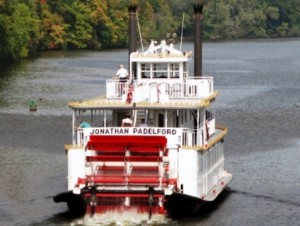 Linda Burton posting from Saint Paul, Minnesota – I went on a cruise today. A Mississippi River Cruise, on a diesel-powered make-believe paddle-wheeler; complete with banjo and song and a few good stories along the way. It was the Lunch and Lock Cruise, a four-hour trip departing from Harriet Island just across the Wabasha Street Bridge from downtown Saint Paul. I’ll tell you some of the tall tales, and I’ll tell you about the river, and the locks; I now hold bragging rights to “locking through Lock #1” on the Mississippi. But first, a tale. As we approached a
Linda Burton posting from Saint Paul, Minnesota – I went on a cruise today. A Mississippi River Cruise, on a diesel-powered make-believe paddle-wheeler; complete with banjo and song and a few good stories along the way. It was the Lunch and Lock Cruise, a four-hour trip departing from Harriet Island just across the Wabasha Street Bridge from downtown Saint Paul. I’ll tell you some of the tall tales, and I’ll tell you about the river, and the locks; I now hold bragging rights to “locking through Lock #1” on the Mississippi. But first, a tale. As we approached a  low-built railroad bridge, you know, the kind that swings open to allow tall boats to come through, our narrator directed us to look at the heavy concrete weight on the short end of it. “It took a year to build,” our storyteller said, “and the man who owned the land next to the right-of-way came out every day and sat in his chair to watch construction. Every day, all day. Finally, it was dedication day, and the man attended the ceremonies, at the conclusion of which he notified the railroad that, when open, the bridge encroached on his
low-built railroad bridge, you know, the kind that swings open to allow tall boats to come through, our narrator directed us to look at the heavy concrete weight on the short end of it. “It took a year to build,” our storyteller said, “and the man who owned the land next to the right-of-way came out every day and sat in his chair to watch construction. Every day, all day. Finally, it was dedication day, and the man attended the ceremonies, at the conclusion of which he notified the railroad that, when open, the bridge encroached on his 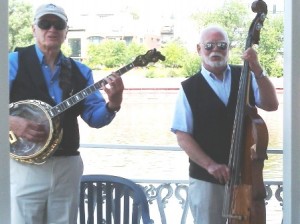 land by a few feet; therefore it could not be used. Railroad officials quickly put their heads together and offered to buy that few feet of land, at the price they paid for land before the bridge was built. The man refused. ‘So now your price has gone up,’ they said. ‘Oh no, my price is the same as it would have been before,’ he replied. ‘And what is that?’ they asked. ‘My price is priceless. The railroad took away my job and ruined my life years ago. I will never sell my land to you, under any conditions.’ The bridge was rebuilt.” » read more
land by a few feet; therefore it could not be used. Railroad officials quickly put their heads together and offered to buy that few feet of land, at the price they paid for land before the bridge was built. The man refused. ‘So now your price has gone up,’ they said. ‘Oh no, my price is the same as it would have been before,’ he replied. ‘And what is that?’ they asked. ‘My price is priceless. The railroad took away my job and ruined my life years ago. I will never sell my land to you, under any conditions.’ The bridge was rebuilt.” » read more
» posted on Saturday, July 13th, 2013 by Linda Lou Burton
Three Men And A Quadriga
 Linda Burton posting from Saint Paul, Minnesota – I won’t lie to you. I was way too chicken to walk out on that upper balcony for a picture of the famous Quadriga. I met two nice women who did though, and shared their pictures with me, so I can show you the awesome sight from high atop the capitol building in downtown Saint Paul. I did take the picture of my car out front, so you can get a perspective of everything I want you to see – the location and size of the Quadriga, and the proximity of the two fabulous domed buildings that bookend John Ireland Boulevard in Saint
Linda Burton posting from Saint Paul, Minnesota – I won’t lie to you. I was way too chicken to walk out on that upper balcony for a picture of the famous Quadriga. I met two nice women who did though, and shared their pictures with me, so I can show you the awesome sight from high atop the capitol building in downtown Saint Paul. I did take the picture of my car out front, so you can get a perspective of everything I want you to see – the location and size of the Quadriga, and the proximity of the two fabulous domed buildings that bookend John Ireland Boulevard in Saint 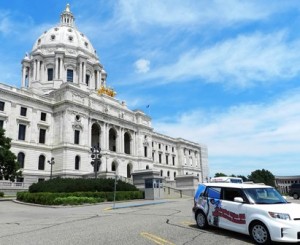 Paul – the State Capitol, which was completed in 1905, and the Cathedral of Saint Paul; construction began on it in 1906. But I’m focusing on the capitol today, and I’ll start with the Quadriga, the shimmery-gold group of sculptural figures named “Progress of the State” perched above the main entrance to the capitol. The grouping consists of a chariot pulled by four horses, and three human figures – two women and a man. The horses represent the classical elements of earth, air, fire and water. The women represent industry and agriculture; together that depicts civilization. The male charioteer represents prosperity; he holds a variation of a Roman Legion standard
Paul – the State Capitol, which was completed in 1905, and the Cathedral of Saint Paul; construction began on it in 1906. But I’m focusing on the capitol today, and I’ll start with the Quadriga, the shimmery-gold group of sculptural figures named “Progress of the State” perched above the main entrance to the capitol. The grouping consists of a chariot pulled by four horses, and three human figures – two women and a man. The horses represent the classical elements of earth, air, fire and water. The women represent industry and agriculture; together that depicts civilization. The male charioteer represents prosperity; he holds a variation of a Roman Legion standard 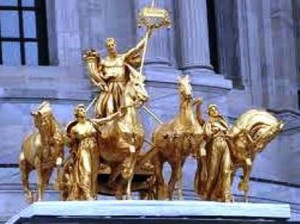 inscribed with the state name Minnesota. The Quadriga is made of copper and gilded in gold, with a few regildings since it first appeared; it was definitely putting on a shine in today’s blazing sun. The quadriga sculptural arrangement goes back over 2000 years to the Roman republic; an emblem of triumph, you’ll find quadrigas on European buildings from Paris to Rome. Sculptors Daniel Chester French and Edward Clark Potter get credit for this one; credit for the capitol goes to Cass Gilbert. » read more
inscribed with the state name Minnesota. The Quadriga is made of copper and gilded in gold, with a few regildings since it first appeared; it was definitely putting on a shine in today’s blazing sun. The quadriga sculptural arrangement goes back over 2000 years to the Roman republic; an emblem of triumph, you’ll find quadrigas on European buildings from Paris to Rome. Sculptors Daniel Chester French and Edward Clark Potter get credit for this one; credit for the capitol goes to Cass Gilbert. » read more
» posted on Thursday, July 11th, 2013 by Linda Lou Burton
The Scoundrel And The Saint
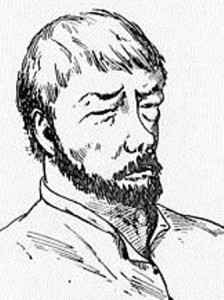 Linda Burton posting from Saint Paul, Minnesota –Every city has both scoundrels and saints in its past, and Saint Paul is no exception. It may have a “saintly” name today, but it started out as Pig’s Eye. Sit back and listen to this tale of two men, and the legacy they left behind. The first character I introduce is Pierre Parrant, a French Canadian born near Sault Ste Marie, Michigan around 1777; he made his living as a fur trapper. He acquired the name “Pig’s Eye” when he became blind in one eye; he began to have troubles with the law when he started bootlegging. Pig’s Eye Parrant claims two distinctions – he was the first person of European descent to live in what became Saint Paul; and he operated the first business there. The second character I want you to meet is Lucien Galtier. He was born around 1811 in Saint Affrique, in the south of France. He became a Roman Catholic priest, and was sent to the
Linda Burton posting from Saint Paul, Minnesota –Every city has both scoundrels and saints in its past, and Saint Paul is no exception. It may have a “saintly” name today, but it started out as Pig’s Eye. Sit back and listen to this tale of two men, and the legacy they left behind. The first character I introduce is Pierre Parrant, a French Canadian born near Sault Ste Marie, Michigan around 1777; he made his living as a fur trapper. He acquired the name “Pig’s Eye” when he became blind in one eye; he began to have troubles with the law when he started bootlegging. Pig’s Eye Parrant claims two distinctions – he was the first person of European descent to live in what became Saint Paul; and he operated the first business there. The second character I want you to meet is Lucien Galtier. He was born around 1811 in Saint Affrique, in the south of France. He became a Roman Catholic priest, and was sent to the 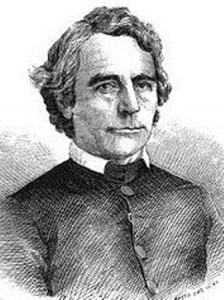 United States as a missionary at the time people were settling near Fort Snelling in Minnesota territory; he arrived at his new post in April 1840. The distinctions he claims are several – he was the first missionary in the area, he built the first churches in what are now the cities of Minneapolis and Saint Paul, and he is responsible for the name of the city of Saint Paul. The church he began in Saint Paul now occupies its fourth building in the city; sitting atop Cathedral Hill and overlooking downtown, it is the third largest church in the United States and a National Shrine. The city of Saint Paul, beginning with the contributions of two men who tackled the wilderness in strikingly different ways, became capital of the state of Minnesota. » read more
United States as a missionary at the time people were settling near Fort Snelling in Minnesota territory; he arrived at his new post in April 1840. The distinctions he claims are several – he was the first missionary in the area, he built the first churches in what are now the cities of Minneapolis and Saint Paul, and he is responsible for the name of the city of Saint Paul. The church he began in Saint Paul now occupies its fourth building in the city; sitting atop Cathedral Hill and overlooking downtown, it is the third largest church in the United States and a National Shrine. The city of Saint Paul, beginning with the contributions of two men who tackled the wilderness in strikingly different ways, became capital of the state of Minnesota. » read more
